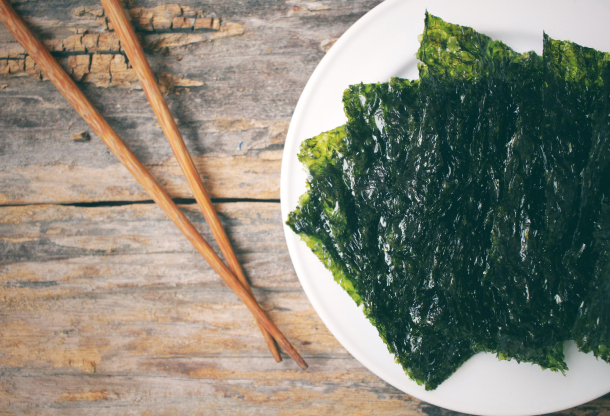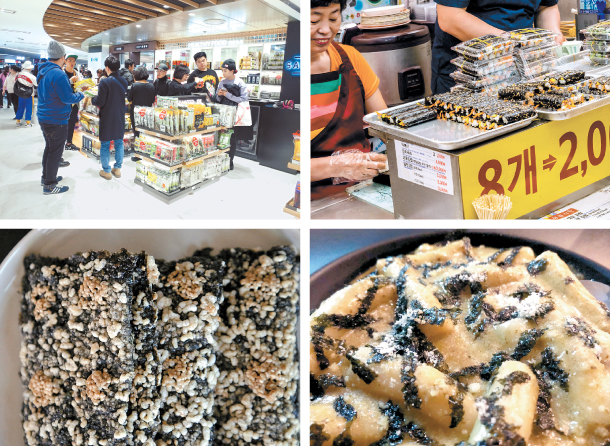[ICONIC FOOD] Korean staple gim finds global appeal: Tourists bring home dried seaweed as a snack, while chefs use it as garnish

There seems to be many people looking for similar food items to bring back home from their trips to Korea these days.
One steady seller that is taking up shelves at department stores, supermarkets and duty free shops is Korean gim, also known as laver.
The seaweed is usually dried in square shapes and is either cut into smaller pieces that one can eat in one bite or a bigger piece that can be cut into multiple bite-size pieces later. They are seasoned with salt and sesame or perilla oil, so it can be a good compliment to any food with a mild taste.
The crispy sound gim makes as you take a bite is enough to make your mouth water. Once you are hooked, you will find yourself reaching for more as the thin slices don’t really fill you up unless you get your hands on a bowl of rice.
Gim has never been seen as something unique to Koreans as it has always been part of banchan, or side dishes, to the staples of rice and soup.
People usually pick up one slice and add a spoonful of rice or other banchan on top. Mixing different ingredients including carrots, eggs and ham with rice and rolling them up in gim, known as gimbap, is a popular Korean snack.

With gim being used in a greater variety of dishes and a growing interest from abroad, shelves at Lotte Duty Free store located in Sogong-dong, central Seoul, top left, are packed with gim for travelers to take home. Some of the ways to enjoy gim, or laver, include making gimbap, rice and vegetables rolled in gim, top right; dried and sweetened with seeds on top, bottom left; and as a garnish to Italian-Korean fusion tteokbokki (rice cakes in spicy hot pepper sauce), bottom right. [LOTTE DUTY FREE, JOONGANG PHOTO, LEE SUN-MIN]
Other ways to use gim include adding it to rice balls along with diced vegetables, or to make gimjaban, a type of banchan, which is made with small chunks of gim marinated in soy sauce and sweet syrup and has sesame seeds mixed in.
Yet, many foreign travelers take a different approach to eating dried seaweed.
While laver is mostly used to complement a meal in Korea, many others, especially those from Thailand, have found that seaweed goes well as a snack. Many local food production companies, small and large, are joining companies overseas to export snacks made with gim. Sometimes they are glazed with something sweet on top, while other times, it has salty flavors with different types of seeds added for more texture.
Even restaurants overseas are adding gim as a motif to complete dishes. At Korean-Italian restaurant Moyo in Hong Kong, chef Jack Lee makes his over variation of the popular Korean dish tteokbokki, rice cakes in spicy gochujang (hot pepper paste) sauce, with pesto to make it more appealing to an international audience and garnishes the dish with gim flakes to add an additional savory taste.
San Francisco restaurant Benu has also used gim in their courses, and French restaurant Le Passe Temps in Lyon, France, serves its foie gras dish with gim powder on top for a fuller taste.
As Korean chefs hold more pop-up events at restaurants in Europe and Asia and use a variety of seaweed in their dishes, chefs abroad have become more ambitious about including the ingredient as well.
The use of gim at many modern Korean restaurants has also intrigued people visiting Korea to learn more about the ingredient’s versatility. Mingles, which now has two stars on the Michelin Guide; Kwon Sook Soo, also with two stars; and Hansik Gonggan which got its first star this year, are some of the restaurants most popular with foreign visitors looking to try the new big thing in Korean cuisine.
One item diners at those restaurants may have tried is called bugak, a dense gim snack. Making it at home is simple. All you need is a pack of unseasoned gim, sesame seeds and some starch water. Apply the starch water layer by layer, and when you have about four layers together, spread some sesame seeds on top. Microwave the layered gim for about two minutes, and when they are cooled down, fry them in oil for another two minutes. Once they have cooled, enjoy them as a snack.
But be careful while you are eating though, as small pieces and gim powder will get all over your clothes, and sometimes, even your lips and teeth may be covered in the dried seaweed as well. Make sure to check yourself in the mirror after you’re all done.
BY LEE SUN-MIN [summerlee@joongang.co.kr]










with the Korea JoongAng Daily
To write comments, please log in to one of the accounts.
Standards Board Policy (0/250자)